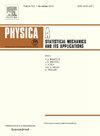Moving boundary truncated grid method: Application to activated barrier crossing with the Klein–Kramers and Boltzmann–BGK models
IF 2.8
3区 物理与天体物理
Q2 PHYSICS, MULTIDISCIPLINARY
Physica A: Statistical Mechanics and its Applications
Pub Date : 2025-01-18
DOI:10.1016/j.physa.2025.130376
引用次数: 0
Abstract
We exploit the moving boundary truncated grid method for the Klein–Kramers and Boltzmann–BGK kinetic equations to approach the problem of thermally activated barrier crossing across non-parabolic barriers with reduced computational effort. The grid truncation algorithm dynamically deactivates the insignificant grid points while the boundary extrapolation procedure explores potentially important portions of phase space. An economized Eulerian framework is established to integrate the kinetic equations in the tailored phase space efficiently. The effects of coupling strength, kinetic model, and potential shape on the escape rate are assessed through direct numerical simulations. Besides, we adapt the Padé approximant approach for non-parabolic barriers by introducing a correction factor into the spatial diffusion asymptote to account for the anharmonicity. The modified Padé approximants are remarkably consistent with the numerical results obtained from the conventional full grid method in underdamped and overdamped regimes, whereas overestimating the rates in the turnover region, even exceeding the upper bound given by the transition-state theory. By contrast, the truncated grid method provides accurate rate estimates in excellent agreement with the full grid benchmarks globally, with negligible relative errors lower than 1.02% for the BGK model and below 0.56% for the Kramers model, while substantially reducing the computational cost. Overall, the truncated grid method has shown great promise as a high-performance scheme for the escape problem.
求助全文
约1分钟内获得全文
求助全文
来源期刊
CiteScore
7.20
自引率
9.10%
发文量
852
审稿时长
6.6 months
期刊介绍:
Physica A: Statistical Mechanics and its Applications
Recognized by the European Physical Society
Physica A publishes research in the field of statistical mechanics and its applications.
Statistical mechanics sets out to explain the behaviour of macroscopic systems by studying the statistical properties of their microscopic constituents.
Applications of the techniques of statistical mechanics are widespread, and include: applications to physical systems such as solids, liquids and gases; applications to chemical and biological systems (colloids, interfaces, complex fluids, polymers and biopolymers, cell physics); and other interdisciplinary applications to for instance biological, economical and sociological systems.

 求助内容:
求助内容: 应助结果提醒方式:
应助结果提醒方式:


